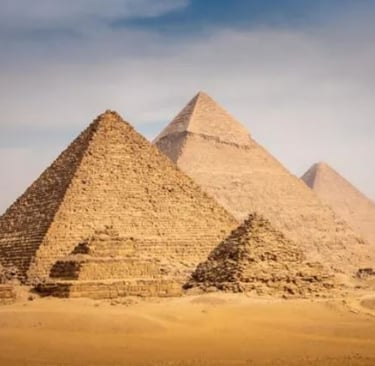Do You Know the Secrets of the Pyramids That Still Puzzle Scientists
#DoYouKnow, #EgyptianPyramids, #GreatPyramidOfGiza, #AncientMysteries, #PyramidSecrets, #History, #Science, #UnsolvedMysteries, #HumanIngenuity, #EngineeringWonders, #WorldHeritage, #AncientCivilizations, #HistoricalFacts, #OrionsBelt, #TombMystery
TECH & SCIENCE
7/26/20253 min read


The Egyptian pyramids have stood for thousands of years as some of the most awe-inspiring and mysterious structures ever built. Despite centuries of study, many aspects of their construction and purpose still baffle scientists, engineers, and historians. The most famous of these pyramids, the Great Pyramid of Giza, continues to challenge modern understanding with its precise architecture, astronomical alignment, and unknown techniques used during construction.
1. The Great Pyramid – A Marvel of Engineering
The Great Pyramid, built during the reign of Pharaoh Khufu around 2560 BCE, originally stood at 146.6 meters (481 feet). It was the tallest human-made structure for over 3,800 years. The accuracy of its alignment to true north, the dimensions of its base, and the uniform size of the stones used are mind-boggling even by today’s engineering standards.
Scientists still debate how such massive stones—some weighing over 70 tons—were quarried, transported, and perfectly placed without modern tools or machinery.
2. Astronomical Precision
One of the pyramid's most mysterious features is its alignment. The sides of the Great Pyramid are closely aligned with the cardinal points (north, south, east, west) with an error of less than 1/15th of a degree. This degree of precision suggests the builders had advanced knowledge of astronomy.
Furthermore, some theories propose that the layout of the pyramids corresponds to the stars in Orion’s Belt, indicating a deeper cosmological significance.
3. The Purpose: Tomb or Something More?
Traditionally, pyramids are considered tombs built to house the deceased pharaohs. However, no mummies or bodies were ever found inside the Great Pyramid. This has led many scholars to consider alternative theories—some believe it was a celestial observatory, others think it served as an energy machine, and some even entertain extraterrestrial involvement.
While the tomb theory is widely accepted, the lack of definitive evidence keeps other ideas alive.
4. Materials and Mystery
The limestone casing stones that once covered the Great Pyramid made it shine like a white jewel under the sun. Most of these stones were removed over the centuries, but some still exist at the base. The precision with which they were cut and placed is so advanced that not even a razor blade can fit between them.
How were these stones cut so precisely? What kind of tools did ancient Egyptians use? This still remains an open question.
5. Hidden Chambers and Modern Discoveries
In recent years, modern technology such as thermal scanning, muon tomography, and 3D imaging has uncovered previously unknown voids inside the Great Pyramid. One of the most significant findings was a massive cavity above the Grand Gallery, discovered in 2017, whose purpose is still unknown.
These discoveries hint that the pyramid might still be holding secrets waiting to be uncovered.
6. Mathematical Mysteries
Some scholars suggest the pyramid encodes advanced mathematical concepts. For instance:
The ratio of the pyramid’s perimeter to its height is approximately equal to 2π.
The golden ratio (φ) appears in its dimensions.
Did ancient Egyptians possess this knowledge intentionally, or is it a coincidence? The debate continues.
7. Pyramids Beyond Egypt
While Egyptian pyramids are the most famous, they are not the only ones. Pyramids are found in Mexico, China, Sudan, and even Indonesia. The global spread of pyramid-building raises more questions—was this knowledge shared among ancient civilizations, or did they discover it independently?
Some suggest a lost advanced civilization could be the source of this widespread architectural phenomenon.
8. Theories and Speculations
Many alternative theories have emerged over the years:
Alien theories: Some believe that beings from another planet shared technology with ancient Egyptians.
Energy plant hypothesis: Suggests the pyramid was used to harness natural energy from Earth.
Acoustic resonance: Some researchers propose that the pyramid’s internal structure amplifies sound in mysterious ways.
While these theories remain speculative, they highlight the endless curiosity the pyramids inspire.
Conclusion
The pyramids of Egypt are more than stone structures—they are testaments to human ingenuity and ambition. They represent a bridge between ancient wisdom and modern curiosity. As technology advances, we may one day unlock all their secrets. Until then, they remain one of the world’s most enduring and captivating mysteries.
Knowledge
Empowering minds with reliable educational content daily.
Newsletter Signup
© 2025 DoYouKnow. All rights reserved.
Stay Ahead of the Trends – Join Our Newsletter
